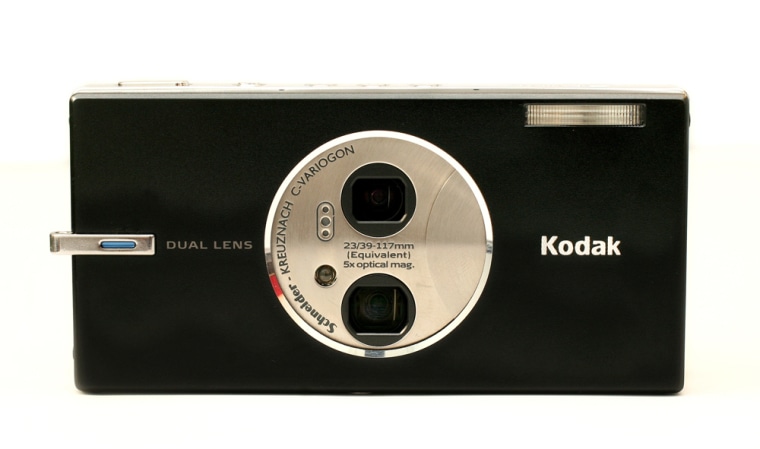If you take a lot of photos, you're bound to occasionally find your camera unable to capture the entire landscape or fit everyone into a close-up group shot.
For that, you'd need a wide-angle lens, but it's mostly available for higher-end, single-lens reflex cameras, particularly if you go digital. Those are the ones with interchangeable lenses.
For compact cameras with built-in lenses, you'd probably want a regular lens because that's what you'd use most of the time.
Enter the EasyShare V570, which its maker, Eastman Kodak Co., bills as the world's first dual-lens digital camera.
For normal shots and close-ups, you use the regular lens, which comes with 3x optical zoom. For wider views, the camera automatically switches to the wide-angle lens.
Think of it as two cameras in one.
I borrowed the V570 to test during a recent vacation to Bangkok and northern Thailand, snapping shots at markets, outside a temple and at various tourist destinations. I used the camera in a variety of lighting conditions, indoors and out.
The camera was fairly easy to use, though I had one beef with storage.
Its internal memory stores 17 shots at the maximum 5 megapixel size, and you can buy an SD or MMC flash-memory card to hold more photos. To switch between the internal and external memory, though, you need to navigate a menu fast enough to avoid losing that picture-perfect moment.
But that's a small complaint.
Picture quality was adequate.
With the wide angle, I was able to boost the field of vision by about two-thirds.
At a botanical garden in Chiang Rai, I got a more complete view of the landscape, amplifying its magnificence.
At an immigration checkpoint re-entering Thailand from Myanmar, a wide-angle shot captured more of a structure where my relatives were filling out papers, producing a shot with a greater feeling of enclosure.
From a pedestrian overpass in Bangkok, the difference meant seeing only the bottom of some trees and all of them with room left for the sky.
Wide-angle lens designs are prone to distortion around the edges. I saw little of it for everyday shots in Thailand. But for test, close-up shots of doorways in New York, what should have been straight lines around the edges came out curved, as if my apartment were sagging under the weight of the ceiling. My landlord wouldn't like the V570.
Distortion aside, the wide-angle lens produced exceptional sharpness right into the corners of the image, better than what I got from the regular lens.
A slight gap exists between the two lenses _ a 70 percent jump in zoom when switching. The fixed, wide-angle lens has an angle of coverage equivalent to 23 mm, while the regular lens starts at 39 mm, zooming to 117 mm. The camera tries to make the switch seamless using "digital zoom," but that's simply a software trick that affects image quality.
The camera's weak built-in flash didn't always light the entire image evenly, though that's a problem regardless of lens.
The V570 has no optical viewfinder but does sport a large 2.5-inch LCD screen. It lets you capture movies and comes with an AC adapter to recharge the replaceable lithium ion battery. Other than the wide-angle lens, the features are largely on par with other point-and-shoot cameras, including the Canon PowerShot SD450 I bought for the trip.
Kodak's EasyShare brand implies easy transfer, and the camera comes with useful features for sharing. For starters, the software that comes with the camera can automatically send photos to Kodak's photo-sharing site.
From your camera, you can mark certain pictures for printing or e-mailing by hitting the "share" button.
You can use your own printer, and from a Windows computer, connect automatically to one of a number of online photo services as well. Unless you're using Kodak's site, you likely have to upload photos manually, but Kodak should be commended for at least offering the choice.
For e-mail, the software automatically pulls up Kodak's Web-based e-mail interface, though I couldn't set up the camera address book from a Macintosh machine.
My chief complaint is that to transfer photos to either computer, you need a bulky "dock" that comes with the camera, along with an outlet to plug it into. The included USB cable won't fit into the camera directly.
The dock is an extra accessory to carry while traveling. My Canon, by contrast, lets me transfer directly to a battery-powered laptop with its USB cord.
Nonetheless, the print and e-mail options are far beyond what my Canon provides.
The V570 lists for $399, which is on the pricey side for point-and-shoot cameras (My Canon, also a 5 megapixel point-and-shoot, lists for $299).
I can see the wide-angle lens being handy if you often find yourself in tight corners, with little room to maneuver for a wider shot. But I truly needed it only once or twice out of more than 800 shots taken in Thailand, Myanmar and Laos.
Most of the time, you can get as good a shot simply by moving back several feet.
Just be mindful of the cliff behind you.
